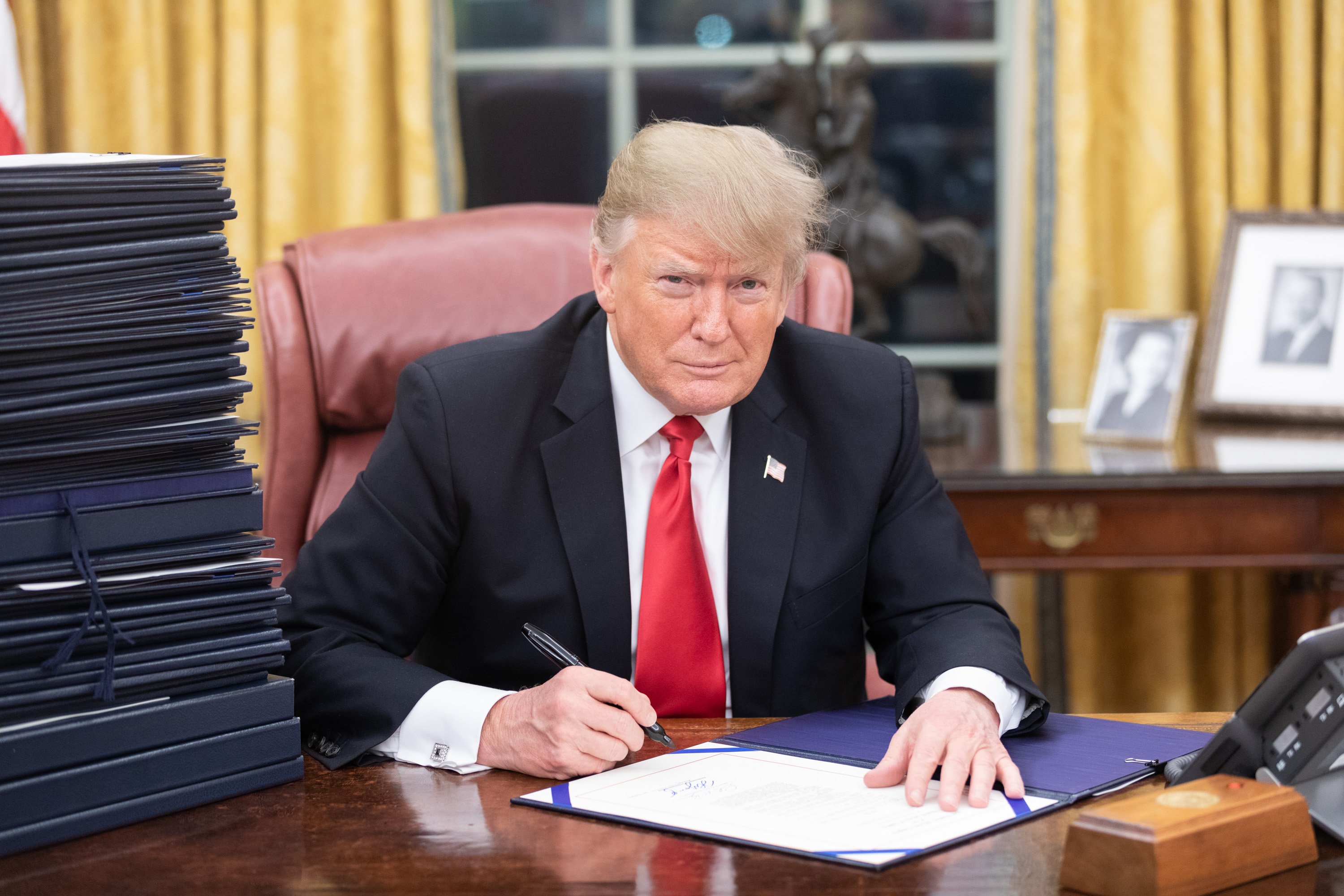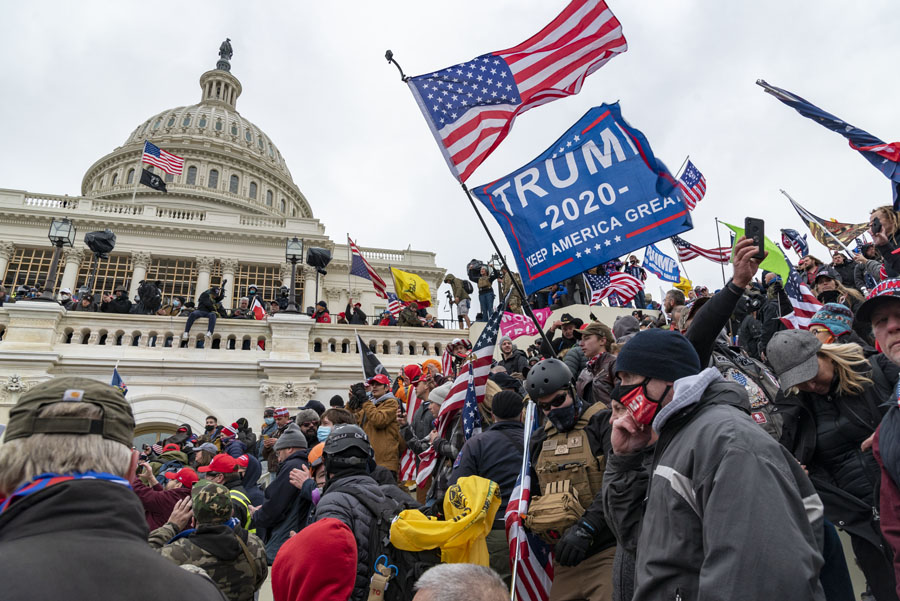You Can’t Designate ‘Antifa.’ Banks and Platforms Will Act Like You Did Anyway.

Published by The Lawfare Institute
in Cooperation With

Not in darkness, but in daylight: The danger here lies not only in what the government can do, but in what people think it can do. With a new executive order purporting to designate “Antifa” as a domestic terrorist organization, the White House has taken an action that is sweeping in its rhetoric yet almost certainly empty of formal legal effect.
That emptiness is by design. The damage is in the announcement. With a few sentences in a White House fact sheet and the stroke of a presidential pen, the government has declared “Antifa” a domestic terrorist organization—and even if that designation likely will not survive legal challenges, it can still do the work of law in the streets, on bank compliance desks, and across social media platforms. The chilling effect is not hypothetical; it is the point.
On Sept. 22, the White House announced that the president “signed an Order to designate Antifa as a domestic terrorist organization,” asserting that “Antifa is a militarist, anarchist enterprise that calls for the overthrow of the U.S. government” and directing the federal government to “investigate, disrupt, and dismantle” its operations and funding. The document catalogs incidents—doxing of officers in Portland, an assault on a journalist, and violence at a march in Pacific Beach—and quotes the president’s declaration: “I am pleased to inform our many U.S.A. Patriots that I am designating ANTIFA … AS A MAJOR TERRORIST ORGANIZATION.”
It is a dramatic pronouncement. It is also, as a matter of positive law, almost certainly a nullity. Designating Antifa as a “domestic terrorist organization” is equivalent to designating fascism or communism: It is a political statement, not a legally operative act.
What the Law Allows—and What It Doesn’t
To understand the purported designation of Antifa, and separate rhetoric from law, we need to look first to the designation authorities Congress has enacted. There are two principal federal designation regimes for terrorism threats: the Foreign Terrorist Organization (FTO) list under 8 U.S.C. § 1189 and the Specially Designated Global Terrorist (SDGT) program under Executive Order 13224, which is exercised under the International Emergency Economic Powers Act (IEEPA), 50 U.S.C. § 1701 et seq. Both regimes are built for foreign threats. The FTO statute applies only to “foreign organizations” designated by the secretary of state. IEEPA authorizes the president to block transactions when there is an “unusual and extraordinary threat” with a source “in whole or substantial part outside the United States.” Executive Order 13224 relies on that foreign nexus.
Likewise, the criminal “material support” offense that attaches to designations—18 U.S.C. § 2339B—makes it a crime to knowingly provide material support or resources to a designated FTO. By its terms, § 2339B is pegged to the FTO list and so does not reach purely domestic groups. There is another material support statute, 18 U.S.C. § 2339A, which prohibits support knowing or intending it to be used to commit a listed terrorism offense, but that provision does not turn on any designation. It relies on proof of intent and connection to specified crimes, not membership in or association with a named group.
The Supreme Court’s leading case on material support underscores the foreign/domestic line. In Holder v. Humanitarian Law Project, the Court sustained the application of § 2339B to coordinated training and advice for designated foreign groups only after emphasizing Congress’s special prerogatives in foreign affairs and national security. Chief Justice John Roberts’s opinion cautioned that the Court’s reasoning should not be read to suggest Congress could impose the same ban on coordinated advocacy with domestic groups, a context where First Amendment protections are at their apex.
At home, the legal architecture stops short. When the focus turns inward, there is no federal authority to designate purely domestic groups as “terrorist organizations.” Congress has defined “domestic terrorism” in 18 U.S.C. § 2331(5), but that provision is definitional only; it creates no designation authority, imposes no listing, and adds no standalone criminal penalties. The definition does have specific legal effects in certain circumstances. For example, it establishes enhanced statutory maximums for select statutes, features as an element in at least one federal offense, and significantly impacts multijurisdictional search warrant authority.
Put simply, there is no statute that authorizes the federal government to designate a domestic organization as a terrorist entity with the legal consequences that attach to FTOs and SDGTs.
Against that backdrop, the White House’s document proceeds from a factual assumption that has long been contested: that “Antifa” is a discrete, structured “organization” capable of being designated, rather than a loose, localized set of networks and tactics. That assumption matters both for statutory authority and for constitutional analysis. Although no statute allows for the designation of a purely domestic group, the closest analogous statute (concerning the designation of foreign terrorist organizations) defines an organization, in part as “a group of persons … associated together with joint action on any subject.” As then-FBI Director Christopher Wray told Congress in 2020, “Antifa” is “more of an ideology or a movement than an organization.”
That does not mean political violence committed by a group or an individual claiming to be “Antifa” is immune from prosecution. It does mean the government must use ordinary criminal law—conspiracy, assault, arson, weapons offenses, seditious conspiracy under 18 U.S.C. § 2384 where proved, and state-law crimes—to deal with it, case by case and with all attendant constitutional safeguards.
What Happens Next—in Court and Beyond
If challenged, the order is likely to face a barrage of claims: ultra vires action (for purporting to impose a nonexistent designation on Antifa); violation of the Administrative Procedure Act’s (APA’s) requirements of reasoned decision-making (for a federal agency exceeding its statutory authority by giving effect to the executive order in some way); and First Amendment challenges if the order makes expressive association a proxy for criminality. When the government has frozen assets under IEEPA without adequate process, courts have not hesitated to find due process violations.
Who brings those challenges? Expect quick pre-enforcement suits by civil rights groups on behalf of local antifascist collectives, journalists, and donors who can show concrete harms traceable to the proclamation—think bank account closures, payment-processor deplatforming, canceled permits, or explicit investigative threats. Those plaintiffs would seek declaratory and injunctive relief against implementing agencies including the Departments of Justice, Homeland Security, and the Treasury, since the White House itself isn’t an APA “agency.”
But litigation is slow, and resolution of these legal questions would be a long way off. The announcement, by contrast, is fast and has an immediate impact. In practice, the consequences of this order flow not from the courtroom but from the actors that will have to respond to it in the face of uncertainty about its yet-to-be-adjudicated legality: the compliance department, the trust-and-safety team, and the human resources office. This is where the designation’s lack of legal teeth may be beside the point.
Banks and payment processors operate under a dense thicket of anti-money laundering rules and risk management obligations. When the federal government signals that a category of people is suspect—even without lawful designation—financial institutions often “de-risk” by exiting customers and transactions to avoid regulatory scrutiny. The recent history of “Operation Choke Point,” in which federal banking regulators informally pressured banks to cut ties with certain lawful but disfavored industries, illustrates how government signaling can induce private choke points without formal rules.
Platforms and employers respond similarly. The Supreme Court warned decades ago in Bantam Books v. Sullivan that informal pressure campaigns by officials can chill speech as effectively as formal censorship and are unconstitutional for the same reason. The government cannot do through intimidation what it may not do by law. Yet “jawboning” is powerful precisely because it harnesses private actors’ risk aversion. A White House declaration that a movement is “terrorist” tells risk managers, newsroom lawyers, and general counsels all they think they need to know.
The chilling effect already described by civil liberties groups follows predictably: Protesters who would otherwise attend a rally stay home; young activists scrub posts; journalists worry that sourcing from, or covering, the wrong protest could expose them to watch listing or investigation; lawyers second-guess whether representing an unpopular client could be reframed as “support.” The boundaries of protected advocacy—sharpened by cases like NAACP v. Claiborne Hardware, which shielded nonviolent boycotts and association from liability—blur when the government blares a terrorism label. And once blurred, they are hard to restore.
The First Amendment Stakes
In First Amendment terms, the risks span speech, association, press, and assembly. Holder upheld only a narrow prohibition on coordinated, expert assistance to designated foreign groups and expressly distinguished independent advocacy—especially in domestic contexts where protections are at their strongest. Branding a domestic movement “terrorist” invites investigators and platforms to treat routine newsgathering as suspect coordination, a form of guilt by proximity the First Amendment forbids. And when protest is recast as a predicate to “domestic terrorism” writ large, the rights of assembly and petition are chilled before any individualized proof of crime—the very inversion of constitutional ordering the law is meant to prevent.
None of this immunizes violence. It is to insist on the constitutional sequencing: Prosecute crimes with individualized proof; do not preemptively punish association or label broad swaths of dissent “terrorism.”
Precedent and Path Dependence
The deepest risk of governing by proclamation is path dependence. Once a president asserts a power—especially under the elastic rubric of national security—future administrations inherit the gesture and the vocabulary. Today’s target is “Antifa.” Tomorrow it could be environmental activists linked rhetorically to “eco-terrorism,” anti-abortion protesters, civil rights groups framed as extremists, or conservative Christian activists. The mid-2010s controversy over the FBI’s “Black Identity Extremists” assessment, ultimately folded into a broader category after criticism, is a reminder of how quickly threat labels can migrate and how hard they are to constrain. Earlier still, COINTELPRO showed how domestic security rationales could be turned inward against constitutionally protected movements.
Internationally, the signal matters too. U.S. officials frequently point to abuse of “terrorism” designations by authoritarian governments to criminalize dissent. Turkey’s broad terrorism laws have swept in journalists and political opponents; Egypt designated the Muslim Brotherhood a terrorist organization; and Russia’s “extremism” framework has been deployed against opposition groups. The U.S. loses credibility in urging rule-of-law restraint abroad if it flouts clear statutory limits at home.
What Courts Can Do—and What They Can’t
Courts are the backstop, and there are reasons to expect aggressive judicial review. A nonstatutory designation of a domestic “organization” for terror-related consequences sits in Youngstown’s “Category Three” (presidential power at its lowest ebb; acting against the express or implied will of Congress). If any concrete sanctions follow—asset freezes, watch listing that affects liberty interests, procurement blacklisting—plaintiffs will argue due process requires notice, evidence, and a neutral decision-maker. If the government invokes IEEPA without a foreign nexus, challengers will note that Congress wrote that requirement into the statute for a reason.
But while courts can enjoin unlawful implementation, they cannot un-say the announcement. Nor can they, alone, restore public trust depleted by repeated executive actions that announce powers first and search for legal authority later. When presidents bypass Congress and statutory limits by proclamation rather than law, they teach the public to expect—and to demand—strongman solutions to complex problems. That is a self-reinforcing loop.
Use the Law We Have
None of this minimizes the harms to people and property wrought by violent political actors, but there is no need to invent tools when they already exist. Federal and state criminal codes are replete with statutes that reach arson, assault, conspiracy, firearms offenses, threats, and targeted intimidation. Where federal “terrorism” enhancements apply to completed crimes, prosecutors can seek them. Courts have upheld prosecutions of organized violence at protests under existing laws, while also trimming provisions that sweep too broadly and risk penalizing protected advocacy.
If Congress believes some form of domestic designation is necessary, it can legislate with special care paid to the following: clear definitions, a high evidentiary bar, robust procedural safeguards, periodic reauthorization, and explicit protections for speech, press, assembly, and counsel. Congress can also strengthen oversight of any informal federal pressure on private actors—jawboning by any other name—so that agencies cannot coerce outcomes they could not mandate.
In the meantime, the executive branch has work it can and should do within the law’s four corners: It should issue public guidance clarifying that the declaration creates no new criminal exposure for advocacy, journalism, or legal representation and that material-support prohibitions remain limited to foreign terrorist organizations; direct Treasury and FinCEN to caution banks and payment processors against viewpoint-based de-risking premised on politics rather than lawful predicates; reaffirm and enforce Department of Justice and Department of Homeland Security policies requiring reasonable suspicion of crime—not ideology or association—to initiate or expand investigations; and commit to transparency by charging specific offenses where evidence exists and, consistent with law and safety, making the supporting facts public.
A Sober Assessment—and a Better Path
The hazards of this moment are not speculative. The United States has seen versions of them before. Informal government pressure has throttled lawful activity without formal rulemaking. Domestic security labels have migrated and expanded, sometimes stigmatizing protected movements. And abroad, regimes have eagerly used the language of “terrorism” to neutralize dissent.
The United States also has a better tradition to draw on—one that treats the Constitution as a constraint even in moments of fear. The Supreme Court has recognized that the government’s interest in combating terrorism is compelling, but also that context matters. The deference in Holder rested on the foreign affairs and national security dimensions that are absent here. The logic of Youngstown, by contrast, speaks with special force to domestic executive claims untethered to statute.
Which is to say: The law already has an answer to a designation it does not authorize. Courts can say so, and likely will. But the damage is in the announcement—because announcements travel faster than injunctions, and because the government’s words can change private behavior overnight. That is why the response must be broader than litigation. It must include institutional self-restraint, congressional clarity, and vigilance by civil society, the press, and the private sector to insist on lawful process over proclamations.
Democracy does not die in darkness; it can be smothered in daylight by a series of norm-breaking declarations that are never quite repudiated. The country is not at that end state, and a brighter future remains plainly available: one in which we denounce and prosecute violence with vigor, and defend constitutional baselines with equal vigor; one in which we resist the temptation to expand power because it is expedient; one in which we remember that the government’s credibility in calling other nations to account depends on its fidelity to its own laws. Recognizing the peril is the first step. The next is to refuse to let an announcement do the work of the law again.



.jpeg?sfvrsn=6117c6bf_4)

